The Primary Cause of Lost Teeth
Many people assume that tooth loss is due to decay. It’s not. It’s because of gum disease. And it can be completely unnoticeable right up until you lose your teeth. Symptoms include bleeding gums when you brush or floss, and loose or shifting teeth. If you’ve been told you need gum surgery, you will be glad to know that it’s possible to control gum disease with a variety of non-surgical methods.

Gum Disease Can Contribute to Heart Disease, Stroke and Alzheimer’s

Medical research has caused many doctors to conclude that gum disease, stroke and heart disease are linked. Recent research has also connected the bacteria that causes periodontal (gum) disease with Alzheimer’s. It is clear that gum disease is a serious matter. The American Dental Association® estimates that eight out of 10 Americans have periodontal disease. If this were any other affliction, such as AIDS or tuberculosis, it would be considered an epidemic! Most dentists think it is just that. They also know that gum disease would never be labeled epidemic because “no one ever dies from it.” The worst is that you lose your teeth. Not pleasant, but certainly not life threatening. But that’s all changed.
The American Academy of Periodontology reports: “Studies found periodontal infection may contribute to the development of heart disease, increase the risk of premature, underweight births, and pose a serious threat to people whose health is already compromised due to diabetes and respiratory diseases.” Periodontal disease is characterized by bacterial infection of the gums. These bacteria can travel into the bloodstream — straight to the heart, the brain and more.
Inflammation is the cause of arterial disease, and the more we learn how to stop the inflammation, the more we can prevent the high prevalence of heart attack and strokes. If we can keep the inflammation down in the mouth, it will greatly reduce the inflammatory process in your arteries. At Arlington Smile Center, we want to help you halt and stabilize arterial disease. Dr. Roca learned the particular pathogens involved in periodontal disease that generate the cardiovascular risk and generate arterial inflammation. During the class, she also learned the importance of endodontic infection in triggering heart attacks. Dr. Roca has invested time and energy in finding ways to report pathogen burden and to more accurately identify endodontic disease.

Now the Good News
With advanced periodontal disease, the treatment is surgical. Gum surgery is never fun, but it is almost always successful in controlling the condition, and it’s usually covered by common insurance plans. With mild periodontal disease, there are very effective non-surgical procedures which, coupled with improved dental hygiene, can virtually halt the spread of the disease. This, too, is usually covered under most dental insurance plans.
What’s So Bad About Losing a Tooth?
Losing even a single tooth can cause the other teeth to shift and move around. This can affect chewing and your ability to absorb nutrients from your food. Other bad things can happen, such as your face changing shape, looking “sunken.” This can make you look much older than you really are. Your speech can be affected. Because it’s harder to chew with missing teeth, you may find yourself favoring softer foods and more carbohydrates, which can cause you to gain weight. The best way to treat a missing tooth (or missing teeth) is with dental implants. An implant can replace one tooth or many. They can be made to look so natural that even a dentist has to look hard to tell the difference.

Dr. Roca is pleased to offer her patients a powerful weapon in the fight against gum disease. It’s called ARESTIN®. It comes in powder form and contains very tiny microspheres that are not visible to the eye. These microspheres deliver a time-released antibiotic directly to the site of the infection (the spaces between the gums and teeth). ARESTIN kills the bacteria that cause gum disease. The best part is that it’s all painless!

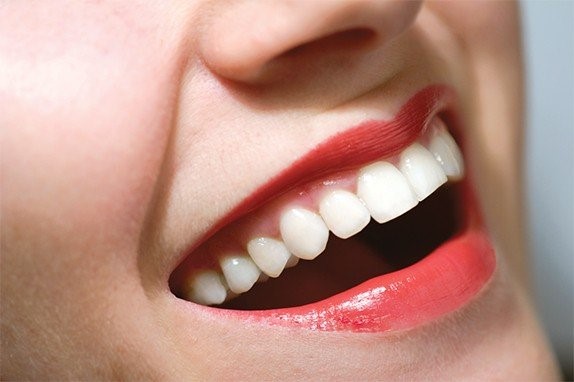
Have You Been Told You Need Gum Surgery?
Our practice uses laser technology for the non-surgical treatment of gum disease, with results that might have been considered miraculous not too many years ago. The procedure is minimal and patient friendly, and the results have been overwhelmingly positive. We have successfully treated many cases of periodontal (gum) disease without the need for traditional gum surgery. We use an advanced dental laser to ensure your treatment is virtually painless. This laser is safe, effective, and FDA-approved. This breakthrough process can actually regenerate bone lost through years of gum disease.
Dr. Roca was awarded the award for Best Periodontal Student in her class at graduation, so you know you are in excellent hands.
Stages Of Gum Disease
Mouth-Body Connection
The daily task of brushing and flossing your teeth has never been more important in order to avoid gum disease and reduce the risks gum disease places on your overall health.
It has been estimated that 75% of Americans have some form of gum disease which can be linked to serious health complications and causes dental problems that are avoidable.
There are three main stages of gum disease: if you had breast cancer, would you want to eradicate it at stage 1 or would you wait to take care of the breast cancer when it hits stage 3. No one would ever wait till their cancer hit stage 3 if they could get it at stage 1 and reverse it. Why wait to treat your gum disease?
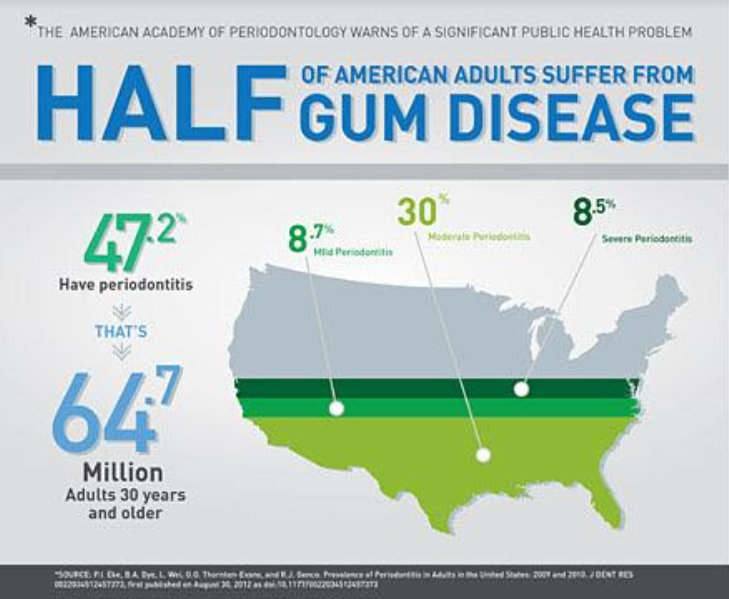
This means 1 out of 2 Americans over the age of 30 has Gum disease ( periodontal disease)
Stage 1: Gingivitis
- Gingivitis is the earliest stage of gum disease and is caused by plaque buildup around the gum line which causes inflammation of the gums.
- If you neglect to brush or floss your teeth daily, this plaque buildup will trap bacteria and cause gum disease.
- Gingivitis causes inflammation of the gums.
- Gums that should otherwise be pink will appear red and swollen; you could experience bleeding when you brush or floss. However, at this point, gingivitis can still be reversed.
- The bone and fibers that hold your teeth in place have not yet been affected.
Stage 2
- If gingivitis is left untreated, the condition will become periodontitis.
- At this stage, the supporting bones and fibers that hold your teeth in place have been irreversibly damaged.
- Your gums begin to form “pockets,” deep hollow areas around the teeth that trap food, plaque, and bacteria.
- Your gums will recede and form gaps between your teeth. Immediate treatment is necessary to prevent further damage and tooth loss.
Stage 3
- In this final stage of gum disease, periodontitis has been left untreated and has become advanced periodontitis.
- Bacteria that was allowed to grow, spread, and cause destruction has destroyed the connective tissues and bones that support the teeth.
- The pockets that formed in the previous stage have become much deeper. Your teeth can shift or loosen.
- Loose teeth that move around in the mouth may affect your bite.
- At this state, aggressive treatment is needed to save the teeth.
Vitamins for Gum Health
Vitamin C
Vitamin C is an essential vitamin important for the growth and repair of all tissues including bones and teeth. Vitamin C also is an antioxidant. Antioxidants help the body prevent some of the damage caused by free radicals, by-products of metabolism. Inflammation and bleeding of the gums are among the signs of a vitamin C deficiency. However, according to the University of Maryland Medical Center, serious deficiencies of vitamin C are rare in industrialized countries. Because smoking depletes vitamin C, smokers have an increased risk of deficiency. Because vitamin C can’t be stored by the body, it must be consumed in food or a supplement every day. A good source is most fruit including citrus fruits, watermelon, pineapple, cantaloupe, kiwi, tomatoes, strawberries, blueberries, raspberries and cranberries. Vitamin C also is found in many vegetables including broccoli, cauliflower, brussels sprouts, cabbage, potatoes and cooked leafy greens, such as turnip and spinach. The University of Maryland Medical Center advises eating fruits and vegetables raw or only lightly cooked since heat can destroy vitamin C.
Vitamins D, K and A
Vitamin D deficiency is implicated in a number of diseases including periodontitis. The Vitamin D council states that blood levels of vitamin D should be between 60 to 80 ng/mL. The body makes vitamin D when the skin is exposed to sunlight, then converts it into its active form. However, if you live in northern latitudes, it’s impossible to produce vitamin D from the sun in the winter because the sun never gets high enough in the sky for its ultraviolet rays to penetrate the atmosphere. Also, some people don’t spend enough time in the sun during the warm months; therefore, vitamin D deficiencies are common. Vitamin D also can be obtained from some foods, such as fish and fortified dairy products, as well as supplements.
When the body converts vitamin D into its active form, vitamin K and a small amount of vitamin A are needed for the process. Both of these vitamins are found in leafy green vegetables. Vitamin A also can be found in orange vegetables and fruit, such as sweet potatoes and cantaloupe.
B Vitamins
The vitamin B complex is made up of eight vitamins. They are thiamine, riboflavin, niacin, pantothenic acid, pyridoxine, biotin, folic acid and B-12. The American Dental Hygienists’ Association lists B vitamins as important to oral health. They are needed for cell growth and for healthy blood, all of which contributes to healthy gum tissue. B-12 is found in animal products, such as meat, fish, eggs and dairy products, but is not naturally found in plant-based food sources. The other B vitamins are found in whole grains and many vegetables, as well as animal products.
Emdogain
Gum disease: the hidden threat to your health
Gum disease is a “hidden” threat to your health. Why? Because even if your teeth look good, seem to be healthy and are free of pain, the issue might lie under your gums, in the teeth supporting tissues such as the jaw bone and the periodontal ligament (the ligament between the teeth and the jaw bone).
In the first stage, the gum becomes inflamed. This is called gingivitis and is reversible.
Emulating nature – the principle of mimicry
Straumann® Emdogain® is a gel that contains specific natural proteins. It mimics the bio- logical process of natural tooth development, promoting regeneration of all periodontal tis- sues. The restoration of the teeth-supporting structures ensures a firm anchorage for your teeth.
Long-term results Straumann® Emdogain® is not a superficial, temporary solution. Because it regenerates your lost tissues in depth, it helps to preserve the tooth in the long run.
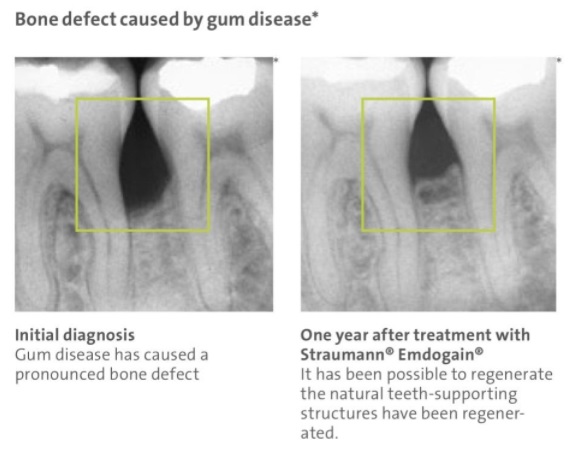
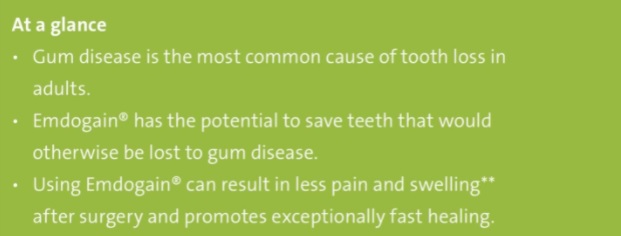
Gum recession: why should you care?
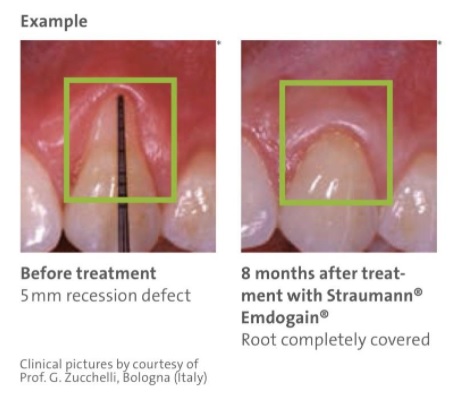 We used to tell our patients we could patch their recession to keep it from being sensitive or we watch it and monitor it,.that is how we were taught to treat gum recession.
We used to tell our patients we could patch their recession to keep it from being sensitive or we watch it and monitor it,.that is how we were taught to treat gum recession.
Not anymore, we get to the root of the problem and figure out what caused the recession, remove the cause and lift the gum to cover the root surface again like new.
We know the function of gum tissue is to cover and protect the roots of your teeth and underlying jaw bone that anchors them in place. When gums recede, the bone and other tissues that support your tooth’s root are also lost. This can compromise your appearance and confidence. The resulting root sensitivity may also make eating and drinking unpleasant or even painful. It is important to identify and treat recession early. Left unchecked, recession could worsen to a point where the root becomes unprotected and teeth may be compromised and lost.
RECEDING GUMS EXPOSE THE TOOTH ROOT AND COMPROMISE THE ATTACHMENT OF THE TOOTH TO THE JAW BONE.
Emdogain®:not only regenerates bone but it is also the gentle solution for gum recession.
- Straumann® Emdogain® is a scientifically proven gel containing natural proteins that is designed to reverse gum recession. Emdogain® is used as part of the minor surgery per- formed by your dentist to move your gum line back to its original position.
Click here for the Recession Brochure
Emdogain is used to help treat and reverse the effects of periodontal disease and gum recession in conjunction with periodontal surgery. Emdogain is made up of a unique group of proteins called enamel matrix proteins. These proteins are the same proteins that helped your teeth develop when you were a child. The proteins are applied directly to the tooth root and are designed to promote the body to form tissue fibers around your tooth, anchoring it in place.
FAQ for Periodontal Disease
When should I brush my teeth?
Brush your teeth for about 2 minutes last thing at night before you go to bed and on 1 other occasion every day.
Your dentist or hygienist may give you more advice based on your own dental health and needs.
Should I use an electric or manual toothbrush?
It doesn’t matter whether you use an electric or manual toothbrush.
They’re both equally good, as long as you brush all the surfaces of all your teeth and you use fluoride toothpaste.
But some people find it easier to clean their teeth thoroughly with an electric toothbrush.
What should I look for in a toothbrush?
For most adults, a toothbrush with a small head and a compact, angled arrangement of long and short round-end bristles is fine. Medium or soft bristles are best for most people.
If you’re using an electric brush, one with an oscillating or rotating head may work better than a manual toothbrush.
But making sure you thoroughly clean your teeth at least twice a day is more important than the type of brush you use. If in doubt, ask your dentist.
What type of toothpaste should I use?
It’s important to use a toothpaste with the right concentration of fluoride. Check the packaging to find out how much fluoride each brand contains.
- Adults should use a toothpaste that contains at least 1,350 parts per million (ppm) fluoride.
- Children don’t need to use special children’s toothpaste. Children of all ages can use family toothpaste, as long as it contains 1,350 to 1,500ppm fluoride. Children aged 6 and under who don’t have tooth decay can use a lower strength children’s toothpaste, but make sure it contains at least 1,000ppm fluoride.
- Children under the age of 3 should use just a smear of toothpaste. Children aged 3 to 6 years should use a pea-sized blob of toothpaste. Make sure children don’t lick or eat toothpaste from the tube.
Your dentist may advise you or your child to use a toothpaste with a higher concentration of fluoride, if you need it.
How to brush your teeth
- Make sure you brush all the surfaces of all your teeth, which should take about 2 minutes.
- Remember to brush the inside surfaces, outside surfaces and the chewing surfaces of your teeth.
Don’t rinse with water straight after toothbrushing
- After brushing, spit out any excess toothpaste.
- Don’t rinse your mouth immediately after brushing, as it’ll wash away the concentrated fluoride in the remaining toothpaste.
- This dilutes it and reduces its preventative effects.
Should I use mouthwash?
- Using a mouthwash that contains fluoride can help prevent tooth decay, but don’t use mouthwash (even a fluoride one) straight after brushing your teeth or it’ll wash away the concentrated fluoride in the toothpaste left on your teeth.
- Choose a different time to use mouthwash, such as after lunch.
- Don’t eat or drink for 30 minutes after using a fluoride mouthwash.
How to use dental floss?
- Take 12 to 18 inches (30 to 45cm) of floss or dental tape and grasp it so you have a couple of inches of floss taut between your hands.
- Slip the floss or dental tape between the teeth and into the area between your teeth and gums, as far as it’ll go.
- Floss with 8 to 10 strokes, up and down between each tooth, to dislodge food and plaque.
- Don’t be too aggressive with the floss: you risk harming your gums.
- The main action of flossing is a firm but gentle scraping of the tooth from the top down.
Why should I use dental floss?
- You’re advised to use interdental brushes in addition to brushing as part of your daily oral health routine from the age of 12.
- Some people may not have large enough spaces in between their teeth to use an interdental brush, so flossing can be a useful alternative.
- Your dental team can show you how best to clean between your teeth.
Flossing tips
- Break off about 45cm (18in) of floss and wind some around one finger of each hand.
- Hold the floss tightly between your thumbs and forefingers, with about an inch of floss between them, leaving no slack.
- Use a gentle “rocking” motion to guide the floss between your teeth. Don’t snap the floss into the gums.
- When the floss reaches your gum line, curve it into a C-shape against one tooth until you feel resistance.
- Hold the floss against the tooth. Gently scrape the side of the tooth, moving the floss away from the gum. Repeat on the other side of the gap, along the side of the next tooth.
- Don’t forget the back of your last tooth.
- When flossing, keep to a regular pattern. Start at the top and work from left to right, then move to the bottom and again work from the left to right. This way you’re less likely to miss any teeth.
What if my gums bleed?
- When you first start flossing, your gums may be tender and bleed a little. Carry on flossing your teeth as directed by your dental team and the bleeding should stop as your gums become healthier. If you floss everyday after 2 weeks you should see the bleeding stop.
- If you’re still getting regular bleeding after a few days, see your dental team. They can check if you’re flossing correctly.
What if I find flossing difficult?
If you find flossing difficult, your dental team can give you advice about other ways of cleaning between your teeth there are hand floss sticks that often makes it quite easy.
How to use interdental brushes?
- You can use interdental brushes or single-tufted brushes instead of flossing, especially if there are gaps between your teeth.
- The brush should fit snugly between the teeth.
- Never use toothpicks to remove trapped food from between your teeth as you may damage your gums, which could lead to an infection.
- Your dentist or hygienist can advise you on the best way to use interdental cleaning for your teeth.
- They have small bristled heads designed to clean between your teeth, and they come in different widths to suit the sizes of the gaps.
- You can buy them from pharmacies and in the supermarket.
How to use interdental brushes
- aim to clean your teeth with interdental brushes once a day
- use a brush appropriate for the size of the space between your teeth – you may need to use more than one size
- insert the brush gently between your teeth, and try a smaller brush size if it feels too tight – don’t try to force the brush into the space
- work round the whole of your mouth so you don’t miss any of the space
What if my gums bleed?
- When you first start using interdental brushes, your gums may be tender and bleed a little as you start to get rid of any plaque build-up. Carry on using the brushes, and the bleeding should reduce as your gums become healthier.
- If you’re still getting bleeding after 2 weeks get advice from your dentist. They can check if you’re using the interdental brushes correctly.
What if I find it difficult to use interdental brushes?
If you find it difficult to use interdental brushes, get advice from your dentist or dental hygienist.
They can show you how to use the brushes and give you advice about other ways to clean between your teeth, such as dental floss. However, some people find using dental floss more difficult.
https://www.straumann.com/content/dam/media-center/straumann/en/documents/brochure/product-information/490.124-en_low.pdf
https://www.straumann.com/content/dam/media-center/straumann/en/documents/brochure/patient-information/490.120-en_low.pdf
https://www.straumann.com/content/dam/media-center/straumann/en/documents/brochure/patient-information/490.119_en_low.pdf
We can help arrest your gum disease and bring your smile back to health. Give us a call today at 703-237-7622.
